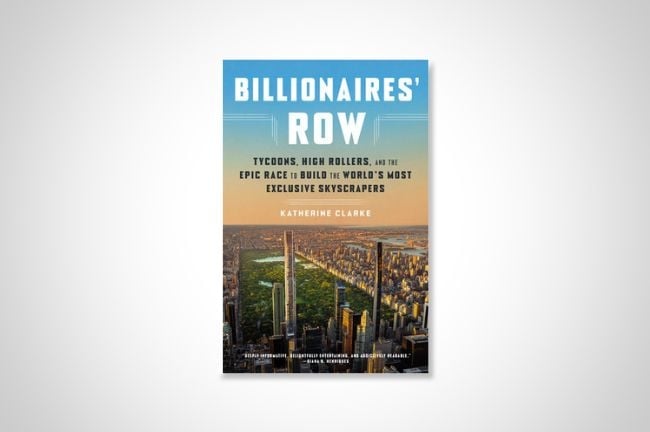You have /5 articles left.
Sign up for a free account or log in.

Penguin Random House
Billionaires’ Row: Tycoons, High Rollers, and the Epic Race to Build the World’s Most Exclusive Skyscrapers by Katherine Clarke
Published in June 2023
The purest expression of the potential and pitfalls of America’s form of capitalism are on display at Billionaires’ Row.
The residential skyscrapers that constitute Billionaires’ Row include One57 (completed in 2014, height 1,004 feet, cost $1.5 billion); 432 Park Avenue (completed in 2015, height 1,396 feet, cost $1.25 billion); the Steinway Tower (completed 2021, height 1,428 feet, cost $2 billion); Central Park Tower (completed 2020, height 1,550 feet, cost $3 billion); and 220 Central Park South (completed 2019, height 950 feet, cost $1.4 billion).
Katherine Clarke’s book Billionaires’ Row is a biography of these buildings. As a Wall Street Journal reporter covering high-end residential real estate, Clarke is ideally positioned to unpack the mix of global economics, New York City zoning regulations and outsize personalities that made these buildings possible.
Anyone interested in the process that real estate developers must navigate to build a supertall residential building, from securing air rights to assembling the capital, will enjoy reading Billionaires’ Row. Those curious about the engineering advances required to build these superskinny skyscrapers will also enjoy the book.
For those willing to squint a bit when gazing from Central Park at these skyscrapers, there may be some lessons (or at least provocations) that higher education can take from Billionaires’ Row.
The most interesting thing about these impossibly tall residential buildings is that they sit mostly empty. Amid a housing crisis, these apartments (which cost $250 million for a seven-bedroom penthouse at Central Park Tower) have little to do with residential living.
For the global superwealthy who buy apartments on Billionaires’ Row, these residences are primarily a way to store (and shield) wealth. Some of the purchased apartments have never been occupied. Others will only have owners staying a few nights a year as they move between the other properties that they own.
We might say in higher education that our universities have nothing in common with the building of Billionaires’ Row. Is that really true? How often do our campuses sit empty? Our expensive learning and living facilities are unoccupied and unused during summer and winter breaks.
The buyers of the apartments in Billionaires’ Row are primarily drawn from the ranks of the global superrich. While a fair number of U.S. hedge fund managers and corporate executives have purchased units on Billionaires’ Row, most apartments appear to be owned as investment properties by ultrawealthy Asian, Middle Eastern and Russian buyers.
Many colleges and universities would be in big trouble without international students. According to one source, the nearly one million students who attend our schools contribute $34 billion to the U.S. economy while supporting over 335,000 jobs. As Northeastern and Midwestern institutions face the impact of demographic headwinds and every school struggles to cover costs, the economic importance of international students for colleges and universities will only grow.
In New York, highly concentrated wealth and a legal structure that privileges the wealthy have resulted in the buildings of Billionaires’ Row. These buildings were allowed to be built despite the shadows they cast on Central Park. Nor do these buildings contribute much in the way of tax revenue, as the NYC property tax system provides enormous discounts for the owners of these apartments.
The fact that these apartments may be unpleasant to live in due to swaying, noise and elevator failures is little consolation for permanently altering the skyline.
Mostly, reading Billionaires’ Row is a warning about the consequences of allowing extreme wealth to determine the structures of our society. It seems like those lessons may apply to higher education as well.
What are you reading?








